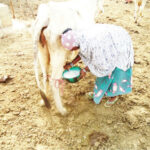Dairy cows that experience heat stress during the dry period have lower milk production in their next lactation.
“Animals that experience heat stress, whether they’re coming into their first or fourth lactation, are going to have lower productivity in their next lactation,” said Geoffrey Dahl, professor at the University of Florida, during a webinar hosted by Hoard’s Dairyman.
“Cows that experience heat stress in late gestation are being programmed for the next lactation,” Dahl said. “We don’t think it has long-lasting implications for subsequent lactations, but at least for that lactation they are going to be programmed for lower productivity.”
Researchers evaluated the birthweight of calves born to dams that were heat stressed or cooled during the dry period.
- Quela birds add to threats on rice farms in Jigawa
- Katsina farmers make fortune from cabbage production
“Calves have a lighter bodyweight relative to their herd mates that were born to a cooled dam,” Dahl said.
In addition to the initial reduction in bodyweight, researchers also looked at immune status of the calves early in life.
“Calves born to a heat-stressed dam have lower immunoglobulin concentrations relative to a cooled dam and that persists through the first month of life, which is when their own immune system is becoming more developed and able to protect them,” Dahl said.
The research shows no difference in immunoglobulin concentrations in the colostrum from cows that were heat stressed or cooled.
“All the calves received about four liters of colostrum, so the apparent efficiency of immunoglobulin absorption is reduced to calves born to a heat-stressed dam relative to animals born to a cooled dam,” the university professor said.
In addition to lower birthweights, Dahl said, calves born to heat-stressed cows also had lower weaning weights.
“Those growth effects appear to persist for a longer time than just around birth,” he said.
There are also indications there may be differences in the composition of the gain in calves.
“Calves born to cooled dams were taller early in life and through weaning relative to animals born to heat-stressed dams,” Dahl said.
“There’s something influencing the capacity of calves that experience in utero heat stress to take up the colostrum they are fed and we may not be able to manage our way out of this after the calves are born,” the professor said.
“The gut closer of calves is well underway even at the time of birth if the animal has experienced heat stress in utero,” he said. “We need to address this before birth to improve their capacity for passive transfer.”
Dahl discussed the long-term impacts on growth of dairy females.
“Heat-stressed animals out to a year of age have lower body weights compared with animals born to a cooled dam,” he said.
Survival rate is another indicator of the problems caused by heat stress.
“The number of heifers that left the herd before puberty was much higher relative to the group born to cooled dams,” Dahl said.
“For reproductive performance, if the animals were heat stressed in utero, it took more services to get them pregnant and the age at pregnancy was a little older.”
Researchers did a slaughter study look at reproductive tissues.
“Animals born to a heat-stressed dam have lower anti-mullerian hormone concentrations relative to heifers born to cooled animals,” Dahl said.
“The ovarian size is not different at the time the animals were born, but by weaning there are already dramatic reductions in the ovarian size in calves born to heat-stressed dams,” he said.
This negative impact on the calves continues to the first lactation.
“There are dramatic reductions in first lactation yields in animals that two years earlier were heat stressed in utero,” Dahl said.
“The first lactation drag was about 5 pounds per day less production, and there was a similar reduction in the second lactation and they make less milk in the third lactation.”
The brief insult late in the fetal development has long-term effects on productivity of the animals.
“Those animals are in the herd about a year less,” Dahl said. “And they appear to pass that onto their daughters.”
To see if season of birth has an impact on longevity of dairy cows, researchers looked at cows in Florida herds that were in their fifth, sixth, seventh or eighth lactation.
“We found almost three-quarters of the animals in later lactations were born during the cooler season of the year,” the university professor said. “And there was a similar pattern in California herds.”
This becomes a factor, Dahl said, when dairymen think about replacement females.
“We need to make sure we do as much as we can to limit exposure to heat stress during late gestation to realize the benefits of cooling the cow and calves,” the professor said.
“The impacts are longer term for the developing fetus and persist for the life of the animal,” he said. “A lot of the insult starts at the level of placental function and the only way to overcome it is to make sure our cows late in gestation have as good cooling as the lactating cows.”
Source: Agrinews

 Join Daily Trust WhatsApp Community For Quick Access To News and Happenings Around You.
Join Daily Trust WhatsApp Community For Quick Access To News and Happenings Around You.

